25 Highlights from 25 Years
May 10th, 2023
Founded in 1998 by attorney Brad Wyche, Upstate Forever has spent the past 25 years forging relationships with business leaders, municipalities, elected officials, community advocates, and fellow conservation organizations. We are proud of our accomplishments, and are honored to continue to serve the Upstate by working to protect its land, water, and special character.
However, we could not do any of this important work without you — our generous supporters, funders, and advocates. You are the reason for the success stories that follow. These are just a few of the highlights (in no particular order) that you've made possible over the last 25 years.
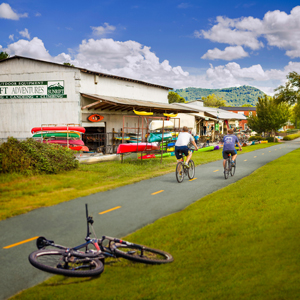
Source: Visit Greenville SC
1. The Prisma Health Swamp Rabbit Trail

Source: Visit Greenville SC
It’s safe to say the Prisma Health Swamp Rabbit Trail has been a game-changer for Greenville County, enhancing quality of life and bringing $9.5 million to the community annually. Upstate Forever played an essential role in securing and opening the trail, as well as catalyzing an extension from downtown to CU-IAR. We continue to actively engage in land use conversations for development around the trail corridor, including the Greenville Development Code. To further support active transit in Greenville, UF also established and operated the Greenville B-cycle program until it was transferred to another system operator in 2019.
2. More funding to accelerate protection of the Upstate’s land & water while there’s still time
As our region grows, the key to timely and effective conservation is funding. Through the years, UF and our partners have advocated successfully for significant funding for conservation at the local, state, federal, and private giving levels. Some examples are the enactment of hospitality taxes in Greenville and Spartanburg Counties to fund parks and greenways; the Oconee County Conservation Bank, the Greenville County Historic and Natural Resources Trust, and the Upstate Land Conservation Fund — that’s millions in funding that goes directly to local Upstate projects.
 3. Achieving the highest standard for land trusts
3. Achieving the highest standard for land trusts

In 2008, UF became the first land trust in South Carolina to receive official national recognition, a distinction granted by the Land Trust Alliance to recognize land conservation organizations that demonstrates sound finances, ethical conduct, responsible governance, and lasting stewardship. Less than 30% of land trusts have earned accreditation, so we are proud we have achieved it and continue to maintain it.
4. 2,600+ visits to steward protected properties
Since Upstate Forever was founded, our team has conducted more than 2,600 monitoring visits. Stewardship allows UF to maintain the conservation agreement with landowners and ensures the permanent protection of a special property through an ongoing relationship between the land and its owners. Our expert Land Trust staff visits each property annually to ensure its conservation values — the natural resources under protection — remain intact.
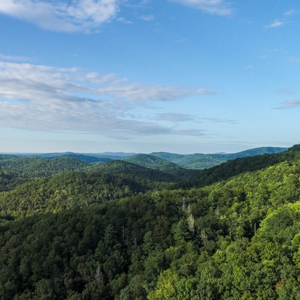
300-acre addition to Jones Gap State Park
5. 30K+ acres protected through conservation easements

300-acre addition to Jones Gap State Park
A conservation easement is a voluntary agreement that honors a landowner’s vision for their property and ensures the land is preserved in perpetuity from large-scale development. Over the years, our Land Trust has partnered with generous landowners, funders, and partner nonprofits to enact 145 conservation agreements that permanently protect more than 30,000 acres of our region’s most critical lands. From the cove forests of the Blue Ridge Escarpment to the working farms of the Piedmont, these are critical properties that safeguard water quality and provide natural habitat. They are also iconic places that attract, teach, heal, and inspire. Here is a sampling of just some of these special places.
- Soapstone Baptist Church, Pickens | 6 acres
Historic church & grounds, founded by freed slaves in the Liberia community | Read more - Spring Park Inn, Travelers Rest | 20 acres
19th-century inn and greenspace right off the Swamp Rabbit Trail | Read more - Oconee Town, Oconee | 54 acres
Historic Cherokee village site with a stunning view of Tamassee Knob - Grant Meadow, Pickens | 57 acres
Iconic Table Rock view off Hwy 11, one of SC’s most photographed spots | Read more - Stumphouse Mountain, Oconee | 519 acres
Public access land with historic, scenic, cultural, & ecological significance - Cragmoor Farms, Spartanburg | 121 acres
Farm-to-table program provides education & produce to students | Read more - Conestee Nature Preserve, Greenville | 379 acres
13+ miles of trails offer ample chances to spot wildlife - Warrior Mountain, Laurens | 318 acres
Iconic granite formation & site of significance for historic Cherokee - Paris Mountain & Jones Gap Additions, Greenville | 1,946 acres
5 easements expanding acreage & access to popular state parks - Nesbitt Shoals, Spartanburg | 201 acres
Blueway and drinking water source at the Tyger River Confluence | Read more - Chauga Heights, Oconee | 212 acres
Striking riverside tract that doubles the size of Chau Ram County Park | Read more - Rocky River Nature Park, Anderson | 132 acres
Unique public wetlands filter water & offer valuable bird sanctuary - Calico Vineyard, Greenville | 115 acres
Scenic family farm providing grapes, berries, & more to local markets | Read more - Greenbrier Farms, Pickens | 124 acres
Farm & event venue practicing regenerative agriculture | Read more - Timber Creek Farm, Laurens | 190 acres
Growing native grasses & pollinator-friendly plants for seed production | Read more - Nalley Brown Nature Park, Pickens | 39 acres
Easy-to-access park with 2.5 miles of trails and a natural playground
With our regional conservation partners, we have also played a significant role in protecting an additional 1,500 acres across eight properties.
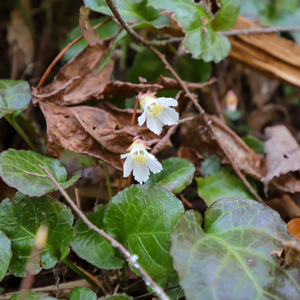
Rare and endangered Oconee bells
6. Conservation & restoration of critical habitat

Rare and endangered Oconee bells
The Upstate is a remarkably biodiverse area — did you know that the Blue Ridge Escarpment has more tree species than all of Europe? Unfortunately, habitat for our native plants and wildlife is often particularly sensitive to development and water quality deterioration. UF works strategically to provide healthy, intact habitat and corridors for local species:
- Identifying our most critical lands
With the support of Pacolet Milliken Enterprises and in partnership with Furman University, we completed a Critical Lands mapping project to identify the region’s most environmentally sensitive lands for water and habitat quality. - Trout habitat restoration on the Saluda
Native trout, once abundant in the Upstate, have been decimated by habitat degradation. As part of the Partners for Trout alliance, UF helped restore nearly 3,000 feet of trout habitat in the South Saluda River. - Threatened plant protection
Through conservation, advocacy, and consultation, we work to protect federally endangered plants like the bunched arrowhead — one of the rarest plants on Earth, found only in Greenville County and Henderson County, NC — and other rare plant species like the Oconee bell and dwarf-flowered heartleaf.
7. Stopping an unnecessary transmission line through the Blue Ridge Mountains
UF helped mobilize public opposition to stop Duke Energy’s proposed substation and 45-mile-long transmission line across the Foothills and Blue Ridge Mountains of the Upstate. The project would have marred the beauty and integrity of an ecologically sensitive landscape, and better options were available to provide effective services. We were able to work with Duke on an alternative solution to install solar facilities and promote energy efficiency. It was a true win-win!
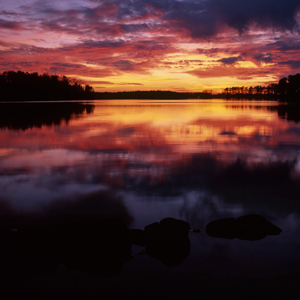
Source: Jon Holloway
8. The Saving Lake Greenwood study

Source: Jon Holloway
By 1999, Lake Greenwood was plagued by pollutants (causing algal blooms thick enough for turtles to walk on!) from upstream sources. UF managed one of the most comprehensive watershed studies ever undertaken in the country to find solutions, and then led implementation of those solutions throughout the Saluda-Reedy Watershed. The result? Significant water quality improvements that allow residents to continue to use and enjoy Lake Greenwood.
9. Five strategic plans to clean up watersheds
When the lands within a watershed are protected and properly managed, it helps maintain water quality, reduce flooding, and increase property values. Thanks to funding from SCDHEC, our Clean Water Team has, over the years, analyzed data and created five strategic watershed-based plans to improve water quality in the Saluda; North/ Middle, and South Tyger, 3&20 Creek, and Lake Keowee watersheds. We also implement these plans through best management practices that tackle bacteria, sediment, and nutrition pollution. To date, that includes 123 septic system repairs, 1,100 feet of streambank restored, 11,475 feet of livestock fencing, 65 acres of conservation cover crops, 8 pet waste stations, and more.
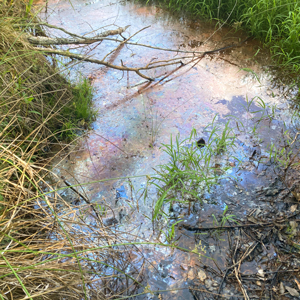
Contaminated water in Anderson County
10. Holding Kinder Morgan accountable for cleaning up a massive diesel spill

Contaminated water in Anderson County
In 2014, the Kinder Morgan pipeline in Belton, SC ruptured and spilled more than 369,000 gallons of gasoline into the surrounding environment. UF partnered with the Southern Environmental Law Center and Savannah Riverkeeper to file a Clean Water Act lawsuit against Kinder Morgan to ensure adequate cleanup, a process that took years and went as far as the US Supreme Court. Kinder Morgan eventually settled for $1.5 million. The Anderson Water Council was then established to oversee the distribution of settlement funds for projects that improve watershed health and community engagement in Anderson County.
11. Connecting people to our rivers and lakes
With support from the Callie and John Rainey Foundation and other partners, UF led coordination of blueway trail mapping throughout SC to catalyze river access across the Upstate. This project connects paddlers of all skill levels to the best water recreation sites across the state via www.PaddleSC.com. We are also proud to have worked with SCDHEC and the Clemson Center for Watershed Excellence to help establish SC Adopt-A-Stream, a citizen-science program that trains residents to monitor water quality in their local waterways.
12. Removal of contaminated dams & sediment
Between 1955 and 1977, a manufacturing plant discharged over 400,000 pounds of polychlorinated biphenyls (PCBs), a highly toxic chemical, into a tributary of Twelve Mile River, resulting in widespread contamination in the river and Lake Hartwell. Alongside the Lake Hartwell Association and Pickens Soil and Water Conservation District, UF successfully advocated for implementation of the federal court’s consent decree to remove PCB-contaminated sediment and two dams on the river.
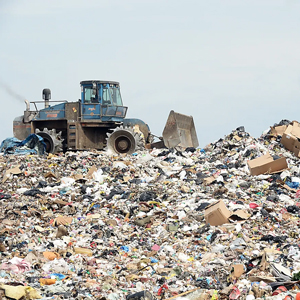
Existing Spartanburg Co. landfill (Source: Alex Hicks Jr)
13. Opposing an unneeded ‘mega-landfill’

Existing Spartanburg Co. landfill (Source: Alex Hicks Jr)
When an unnecessary and redundant mega-landfill was proposed in Spartanburg County in 2005, we joined efforts to successfully stop its development, in addition to promoting waste reduction and recycling through collection events for household hazardous waste and pharmaceuticals.
14. Local land use policies that encourage green space, reduce sprawl, and enhance mobility
From the beginning, UF has recognized that conservation and land use policy go hand in hand. While this kind of advocacy can be slow-moving and incremental, it is essential to our future if we want to balance growth with other community priorities like greenspace and affordable housing. We celebrate the successful policies UF has advocated for, including:
- More robust protection for vanishing tree canopy, City of Greenville | 2021
Greenville City Council adopted a substantially revised and strengthened tree ordinance in an effort to protect remaining tree canopy within the city limits. Urban tree canopy is critical for sequestering carbon, removing air pollutants, filtering stormwater, slowing runoff, providing cooling shade, and reducing urban heat island effects. - A more inclusive downtown development code, City of Spartanburg | 2015
This regulatory structure implemented the vision and goals of the Downtown Master Plan by first establishing formbased regulations for the development and redevelopment of the central business district, and then expanded into the Northside Neighborhood. - Promoting sidewalks & bike paths, City of Clemson | 2018
This was a major revision to the city’s land development regulations, establishing and/or strengthening regulations related to tree canopy and requirements for developers to install sidewalks/bike paths identified in adopted plans. - Empowering rural landowners, Greenville County | 2021
With input from rural landowners and local farmers, County Council established an “Agricultural Preservation” Zoning District, providing citizens with an important voluntary tool to preserve the county’s remaining farmlands. - Preserving the character of Highway 11, Pickens County | 2022
UF supported a citizen-led effort to adopt a Pickens County ordinance aimed at protecting the unique beauty of the Scenic Highway 11 Corridor through design standards and development limitations. The ordinance will ensure development along this iconic route is in keeping with its scenic and rural character. - Breakthrough ordinances encouraging thoughtful growth, Spartanburg County | 2019
The Spartanburg County Performance Zoning for the southwest region enabled mixed-use development for the first time in unincorporated areas of the county while providing protections for compatibility with residential and other uses. A Road Classification Plan and new subdivision regulations laid the groundwork for future adoption of performance zoning for other unincorporated regions of the county. - Strengthened protection for unzoned rural land, Greenville County | 2021
To address rapid development of rural land, County Council established Rural Conservation Subdivision Guidelines to apply to all unzoned properties in the unincorporated area, which strengthened protection for riparian buffers and open space and maintained protections for endangered and threatened species. Simultaneously, Council strengthened requirements for developers to share in the cost of needed infrastructure upgrades and mitigate traffic impacts.
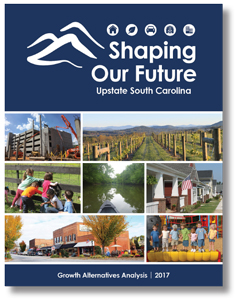 15. An eye-opening growth projection study
15. An eye-opening growth projection study

UF and partners released a landmark Upstate Growth Study conducted by Clemson University’s Strom Thurmond Institute in 2008, followed by another eye-opening growth alternatives analysis in 2016 – both highlighting the trade-offs of various growth choices and what our region will look like decades from now if current development patterns and policies remain unchanged. Long story short: the studies found that the Upstate is consuming land at an alarming rate, and it is imperative that we explore alternatives to this sprawling growth pattern.
16. The Impact Greenville coalition
Coalition work is an important aspect of our work, especially as part of collective advocacy. To more effectively advance better land use policies, we partnered with local stakeholders to establish Impact Greenville, a diverse coalition working to shape public policy at the intersection of housing, transportation, and land use. Impact Greenville also hosts thought-provoking community education events to advocate for policy change.
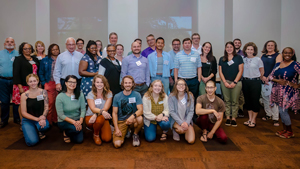
Citizens Planning Academy class of 2022
17. 250+ citizens engaged in advocacy training & events

Citizens Planning Academy class of 2022
UF is dedicated to demystifying the land use planning process for local residents. Since 2019, we’ve engaged over 250 Greenville residents in Citizens Planning Academies, advocacy trainings, and postcard-writing social events. The academies help residents navigate the policy making process and give them the tools to influence it.
18. The Active Living event series
From 2012-2015, UF hosted the quarterly Active Living event series based in Spartanburg County and sponsored by the Mary Black Foundation. The series was designed to encourage community dialogue about policies and infrastructure that promote physical activity to improve public health.
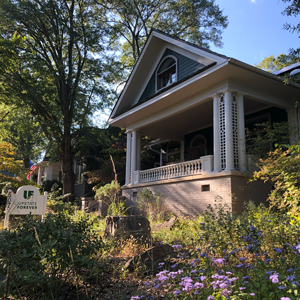 19. Greenville Office Project
19. Greenville Office Project

Following UF’s first-ever capital campaign, we completed the LEED Platinum-certified renovation of our Greenville office meeting EarthCraft green building standards. This project set an example for the adaptation of existing structures to meet modern, environmentally-conscious standards. Our office, located at 507 Pettigru Street, features: a roof made of sustainably-harvested wood and treated with a nontoxic preservative that prevents decay, reclaimed heart pine flooring from three Upstate textile mills, solar panels that provide about a quarter of our electrical power, a “green roof,” native plant landscaping, and rain barrels for irrigation.
20. Advocacy for clean energy solutions
UF works at the state level to reduce unnecessary energy infrastructure while we lay the groundwork for a regulatory and policy environment that encourages clean renewable energy, energy storage, demand side management, and energy efficiency in the most flexible and cost-effective manner possible. Some energy successes:
- The 2019 Energy Freedom Act to protect rooftop solar, allow for public engagement in utility resource plans, protect customers from rising costs, preserve the ability to manage individual energy use, and promote utility adoption of clean energy resources.
- The 2019 Solar on Superfund bill and 2020 Market Reform Study bills that advance the state’s pro-solar actions and address utility regulation.
- Intervening in Public Service Commission dockets to hold electric utilities accountable and advocate for initiatives that reduce our reliance on fossil fuels.
21. Addressing harmful coal ash storage
UF worked with the Southern Environmental Law Center to secure a voluntary agreement with Duke Energy in 2015 for the excavation of the Lee Steam Station coal ash ponds located along the Saluda River in Anderson County. We also helped with the effort to stop a proposed coal ash landfill in Pickens County.
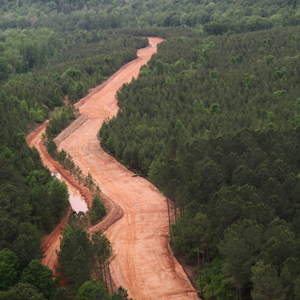
Pipeline construction
22. Keeping a watchful eye on pipeline plans

Pipeline construction
We act as a watchdog for harmful pipeline projects and advocate for accountability between pipeline companies and local communities. UF has worked with residents to vet pipeline plans and oppose unnecessary ones, including a line proposed by Piedmont Natural Gas in 2020 and 2021 in sensitive ecosystems and working lands in Northern Greenville County.
23. State conservation and resilience funding
UF has been working with the SC Office of Resilience and other advocates on the new agency’s task force to develop the State Resilience Plan which would apply policies that benefit Upstate communities, including nature-based solutions and strategic land conservation.
24. Working to combat toxic “forever chemicals”
Known as “forever chemicals,” PFAS — toxic per and polyfluoroalkyl substances — are found widely throughout SC’s water supply. In recent years, UF has been investigating PFAS contamination in Upstate drinking water systems and working with SCDHEC and advocates to develop legislation and regulations to protect citizens from exposure.

Source: Explore Pickens County
25. Protecting Glassy Mountain

Source: Explore Pickens County
In 2017, we successfully appealed a proposed 254-home subdivision that would have forever altered the character, landscape, and hydrology of Glassy Mountain, a Pickens County icon. We worked with the landowners and community members to realize a conservation solution, and the mountain view will remain intact for all to enjoy.
+ Looking Ahead
We are excited about the future, and are already working on some new initiatives that will continue to transform the Upstate while protecting its natural resources and enhancing quality of life. Here are a few projects and focus areas we have in store:
- Saluda Grade Rail Trail
We are hard at work facilitating, with partners, a potential rail trail following the unused Saluda Grade rail line for approximately 31 miles through Upstate South Carolina and Western North Carolina. The trail would be a transformational recreation amenity for our region. Visit SaludaGradeTrail.org for more information and updates. - Tyger River Confluence Park & Blueway
Alongside the Tyger River Foundation and other partners, UF is working to protect four beautiful parcels on the Tyger River totaling 201 acres with 2.5 miles of river frontage and prominent features, including 136- acre confluence property, Tyger 10 Nature Park, Nesbitt Farm, and the future location for the Tyger River Nature Center. This interconnected system of properties and recreational facilities will promote public recreation opportunities for the community. - Protecting high-priority small parcels
Although our Land Trust typically prioritizes protection for large properties, we realize there are many smaller properties that offer an outsized contribution to the region’s conservation footprint and quality of life. This may include urban greenspaces, iconic historic/cultural grounds, and neighborhood parks. We are also seeking to address historic inequities by intentionally working to protect more properties within historically underserved communities or owned by an individual who identifies as a person of color. - Electric Vehicles
UF is renewing focus on making electric vehicles accessible and identifying common-sense approaches to electrification and barriers to adoption. This spring, we are hosting an “EV Equity Summit” to facilitate collaboration among Greenville communities and other stakeholders to ensure we are effectively advocating for policies that equitably increase mobility, neighborhood connectivity, and reduce pollution. - Enhanced Land Management
We’re excited for our new Land Management Program that enhances the land conservation work we already do by communicating techniques, impacts, and lessons learned to landowners and the larger community; promoting the natural resiliency of protected properties by combating invasive plants, restoring grasslands, building trails, and installing native plantings; and engaging the community.

